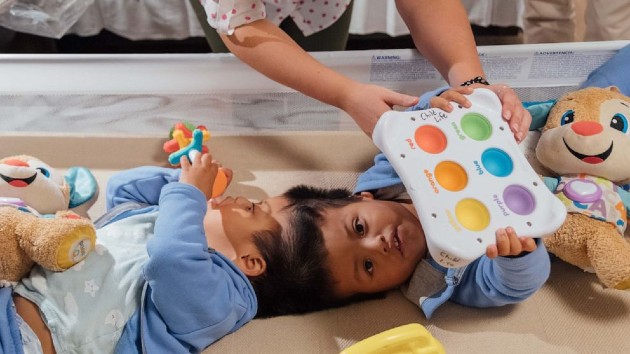(NEW YORK) — Doctors in Ohio performed a groundbreaking surgery to separate conjoined twins, the first of its kind due to the twins’ age and the complexity of their condition.
When the doctors at Dayton Children’s Hospital in Ohio first heard about Guatemalan conjoined twins Pedro and Augusto in 2019, who were connected at the head, they worked quickly to bring the boys to Ohio to perform multiple surgeries.
The already complicated process was drawn out and made even more difficult after Guatemala implemented travel restrictions due to the COVID-19 pandemic, but the separation surgery was finally made possible in April of 2022, when the boys were 3 years old.
Dr. Christopher Gordon, chief of craniofacial and reconstructive surgery at Dayton Children’s, and Dr. Robert Lober, a pediatric neurosurgeon at the hospital, knew they had their work cut out for them. No one had ever performed this operation on twins this old, or on twins that shared vascular structures, meaning one boy’s veins and arteries were feeding the other, and vice versa.
The doctors successfully completed the historic separation over six months, performing three surgeries over the first four months to first separate the twins’ veins and arteries before a fourth separation surgery. The hospital documented the entire process in the film Connected: The story of the seemingly impossible separation of Pedro and Augusto.
Gordon and Lober spoke exclusively with ABC News’ Kayna Whitworth about the experience.
“I mean, they were right at the edge of organ failure, just from the changes in load as we did each stage. So, I think if we’d tried to do more of this at once, they probably wouldn’t have made it,” said Gordon.
As pressure mounted surrounding the final operation, doctors discovered another large artery connecting the boys, with dangerous consequences to Augusto’s speech and motor skills if separated.
“It took a personal toll,” said Lober, speaking about the pressure the medical team faced in that moment.
Some nurses even had to leave the room, overcome by emotion, says Lober.
“Everybody was suffering,” Gordon added.
Eventually, after three long days in the operating room — the boys were separated.
Then, 14 months after the successful separation, the twins were able to return home.
“These were boys that we’d come to love over a long period of time,” said Lober. “Everybody’d come to love. They became our boys.”
These doctors have helped change the landscape of facial, cranial surgery and Gordon says there’s now a line of 60 kids with other complicated syndromes, who are hoping to come to Dayton Children’s Hospital for help.
Copyright © 2023, ABC Audio. All rights reserved.












